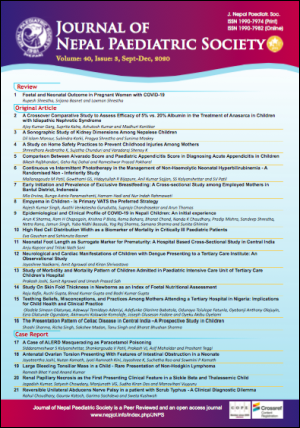High Red Cell Distribution Width as a Biomarker of Mortality in Critically Ill Paediatric Patients
DOI:
https://doi.org/10.3126/jnps.v40i3.29596Keywords:
critically-ill children; death; red cell distribution widthAbstract
Introduction: Red cell distribution width (RDW) is a frequently overlooked parameter in routine haematological reports. It is a simple and inexpensive test which has been found by many adult studies to be a prognostic indicator of mortality in intensive care units. The objective of this study was to see if high RDW could be used as a marker to predict mortality in critically ill children.
Methods: This was a prospective observational study conducted in the paediatric intensive care unit (PICU) of a tertiary hospital of Western Nepal over a period of one year. Study subjects were selected by purposive sampling method. RDW at admission and relative change in RDW (ΔRDW) was compared to see if they had any role in predicting mortality in this group of children. Receiver operating curve analysis was plotted to find an optimal cut-off point to define high and low RDW and various outcome parameters were analysed.
Results: Out of 131 children, there were 12 (9.1%) mortalities. Admission RDW was higher in the death group as compared to the survivor group (17 vs 14.6; p = 0.012). Similar finding was seen with ΔRDW (0.45 vs 0.00; p = 0.006). ΔRDW above the cut-off value of 0.15 was found to be associated with a generally more complicated course during hospitalisation as well as had more risk of mortality.
Conclusions: Both RDW and ΔRDW above the cut-off value were found to be associated with mortality. In addition, high ΔRDW was also found to predict a more complicated course during hospitalisation.
Downloads
Downloads
Published
How to Cite
Issue
Section
License
Authors who publish with this journal agree to the following terms:
Authors retain copyright and grant the journal right of first publication with the work simultaneously licensed under a Creative Commons Attribution License that allows others to share the work with an acknowledgement of the work's authorship and initial publication in this journal.
Authors are able to enter into separate, additional contractual arrangements for the non-exclusive distribution of the journal's published version of the work (e.g., post it to an institutional repository or publish it in a book), with an acknowledgement of its initial publication in this journal.
Authors are permitted and encouraged to post their work online (e.g., in institutional repositories or on their website) prior to and during the submission process, as it can lead to productive exchanges, as well as earlier and greater citation of published work (See The Effect of Open Access).



